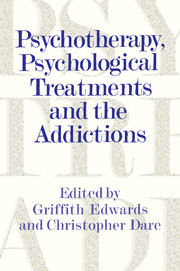Book contents
- Frontmatter
- Contents
- List of contributors
- Psychotherapy and psychological treatments of substance problems: generalism, specialism and the building of bridges
- Acknowledgements
- Part one Backgrounds to therapeutic understanding
- 1 Addictions over the life course: therapeutic implications
- 2 Psychotherapy and the life cycle: individual and family
- 3 Personal strengths and vulnerability in family and social context
- 4 Therapy in the eye of history: three episodes from the nineteenth century experience
- Part two Treatments
- Part three Postscript
- Index
3 - Personal strengths and vulnerability in family and social context
from Part one - Backgrounds to therapeutic understanding
Published online by Cambridge University Press: 05 August 2016
- Frontmatter
- Contents
- List of contributors
- Psychotherapy and psychological treatments of substance problems: generalism, specialism and the building of bridges
- Acknowledgements
- Part one Backgrounds to therapeutic understanding
- 1 Addictions over the life course: therapeutic implications
- 2 Psychotherapy and the life cycle: individual and family
- 3 Personal strengths and vulnerability in family and social context
- 4 Therapy in the eye of history: three episodes from the nineteenth century experience
- Part two Treatments
- Part three Postscript
- Index
Summary
Introduction
This chapter will consider some of the social and family factors that create a stressful context for children growing up. The impact of life events as additional stressors is discussed. There is no attempt to put this together with the abuse of drugs, which is attended to elsewhere in the book. However, the relationship between social disadvantage, stressful life events, and the recourse to drugs will be apparent to many readers.
As discussed in Chapter 7 a systemic approach to treatment is one that considers problems in the context both of intimate relationships and of the wider social network of which an individual is a part. The intimate relationships within which a young person exists have a developmental aspect, and a life span perspective. This means that the social boundaries relevant to the growing child will constantly be in change. Society will also place demands for change relating to culture, class and race. Gender will in addition create widely differing expectations in relation to role within the family (Gorell Barnes, 1995).
Using a systemic lens, four broad principles for looking at the connection between individuals and families may be useful.
People in families are intimately connected, and focusing on those connections can be a more valid way to understand and promote change in problem-related behaviour than focusing on the perspective of any one individual.
People living in close proximity over time set up patterns of interaction made up of relatively stable sequences of interaction.
The patterns of interaction, belief, and behaviour that therapists observe and address can be understood both as cause and effect of the problem: the ‘fit’ between the problem and the family.
Problems within patterns of family life are related to inappropriate adaptation to some environmental influence or change, either realised or anticipated (Gorell Barnes and Cooklin, 1994).
Mutual influence and family life
In the last decade much research into family life and the onset of different forms of psychological illness has explored the impact of stressful life events in terms of the meanings that these events are given by individuals, and the impact of these meanings on subsequent choices of relationship (Dohrenwend and Dohrenwend, 1984; Brown et al., 1986; Brown, 1990, 1991; Harris et al., 1990).
- Type
- Chapter
- Information
- Publisher: Cambridge University PressPrint publication year: 1996

